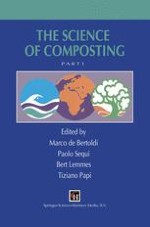1996 | OriginalPaper | Buchkapitel
Phytohygienic aspects of composting
verfasst von : G. J. Bollen, D. Volker
Erschienen in: The Science of Composting
Verlag: Springer Netherlands
Enthalten in: Professional Book Archive
Aktivieren Sie unsere intelligente Suche, um passende Fachinhalte oder Patente zu finden.
Wählen Sie Textabschnitte aus um mit Künstlicher Intelligenz passenden Patente zu finden. powered by
Markieren Sie Textabschnitte, um KI-gestützt weitere passende Inhalte zu finden. powered by
The majority of plant pathogens do not survive exposure to conditions prevailing during composting of infested plant residues. The most resistant pathogens are heat-resistant viruses and biotrophic root-infecting fungi. Most soil-borne viruses need nematodes or fungi for infection of the host plant. Since the vectors are destroyed during composting when properly performed, the product is not infectious. Apart from a few viruses, e.g. tobacco necrosis virus (TNV), virus particles in compost are not picked up by vectors that are resident in compost-amended field soil. Tobacco mosaic virus (TMV) is not completely inactivated. Since it can be directly transmitted to the plant root, i.e. without a vector, compost from infested residues should not be used in susceptible crops. Data on survival of other heat-resistant viruses that are mechanically transmitted are lackingSurvival of biotrophic fungal pathogens was only studied for Plasmodiophora brassicae and the virus vector Olpidium brassicae. Although the results are not consistent, it is tentatively concluded that these fungi are eliminated after exposure for one day to compost at 60 _C and a moisture content of 40%. Concerning trade of plants in compost-amended substrates within the EC countries, research on survival of composting by quarantine pathogens mentioned in Council Directive no 77/93/EEC is needed.Among the factors involved in inactivation, heat is considered to be the main factor in composting under predominantly aerobic conditions and toxic agents in decomposition under anaerobic conditions.The present sampling techniques and detection methods for plant pathogens in compost do not allow a reliable analysis for the evaluation of infestation of the finished product. An alternative is defining the conditions required for sanitation that should be maintained during the process for sanitation.
